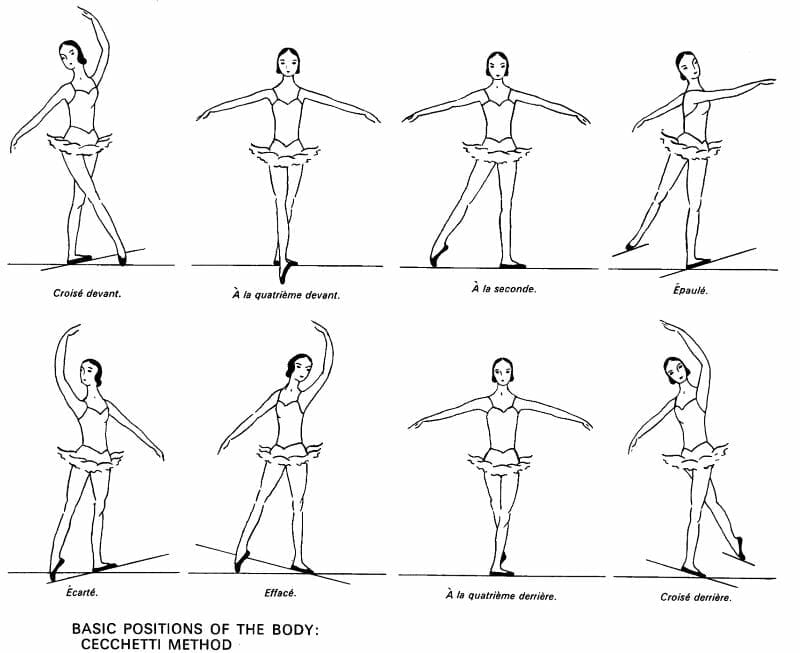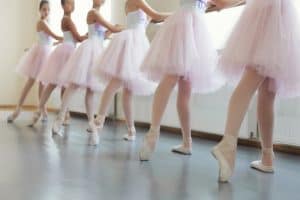Classical ballet uses 8 basic positions of the body. All of the other movements are done in or through these positions. It is essential to know and understand them in order to correctly execute various ballet movements.
The following list will tell you about each of the 8 positions in the traditional order. Each position has a French name that is used to refer to that position across many different steps.

1. Croise Devant
Croise devant translates to ‘crossed alignment to the front.’ This position begins with the dancer facing the corner with the leg closest to the audience in front of the other. The leg closest to the audience is then extended in a tendu, which means ‘stretched’.
The arm closest to the extended leg is placed in second position (or to the side) and the other arm is up in third position. Depending on the technique that you are studying, the top arm’s position may be also called ‘fifth position.’ The head is facing the audience.
This body position is used for a lot of steps done in the center of the room. It can be used at the barre, but this is less common in most ballet classes. This position can also include placing the front foot down to create a fourth position and is a common starting place for pirouettes, usually with altered arm placement.
2. Quatrieme Devant
The second position of the body is called quatrieme devant. This position is similar to croise devant, except it is done facing the audience rather than the corner. One leg is extended to the front in a tendu.
Both arms are extended to the sides in second position. The head is always facing the audience, which is straight ahead in this body position.
This position is often used at the barre (turned to work with one hand on the barre) as well as for some steps in the center of the room. Coda turn sequences often start in this position as well as many common exercises done in class, such as tendus, degages, and more.
3. Efface Devant
Efface devant is the third position of the body used in classical ballet. Efface means ‘shaded’ in French and devant means ‘to the front.’ This is because the inside leg is extended in a tendu while the body faces the corner. This means that your extended leg is ‘shaded’ by your body.
This position is done by facing the corner. The leg further from the audience is in a tendu in front of the body. The arm closest to the audience is raised in a third position and the other arm is extended in second. The head is facing the audience, looking under the arm that is raised.
This is a more open position than the others. It is often used by men in pas de deux scenarios, as it leaves room for the woman to be in front of him. It is also used in waltz combinations in the center along with a lot of other steps.
4. a la Seconde
The fourth position of the body is called a la seconde. This position is performed by facing the audience. The arms are out in second position and the head is facing the front. The combination of the arms and head and body orientation to the audience is called ‘en face’ and is used in many of these body positions.
One of the dancer’s legs must be extended to the side in second position in order to be in a la seconde position. This is often used as preparation for a movement or as a simple exercise for tendus or degages.
Most notably, a la secondes are popular turns in many styles of dance. These are done with the leg raised in second. These turns are done in ballet occasionally, but are more often used in contemporary or jazz dance styles.
5. Croise Derriere
Croise derriere is the fifth position of the body and the reverse of croise devant, which is the first body position. This position starts the same as its devant counterpart, by facing the corner with the head turned towards the audience. This creates the ‘crossed alignment’ that croise gets its name from.
This position of the body involves the leg further from the audience being extended in a tendu behind the dancer. The arm closest to the audience is raised in third position, with the same arm as extended leg is out in second position. This means the dancer is looking under their raised arm.
6. Ecarte (Devant and Derriere)
Ecarte is the sixth position of the body in classical ballet. This is done in croise, which means the dancer is facing the corner. Ecarte comes in two different flavors: devant and derriere. Both include one of the dancer’s legs being extended to the side and the same arm as leg being up in the third, with the other in second.
Ecarte devant uses the leg closest to the audience. This leg is extended to the side in a tendu and the same arm is raised in third position. The head is turned towards the raised arm and is tilted slightly up into the hand.
Ecarte derriere uses the leg that is further from the audience. This leg is extended in a tendu with the same arm raised in third position. The head is turned towards the audience, but tilted slightly down into the hand.
When performing the eight positions of the body in order, ecarte devant is always used and ecarte derriere is not. It is important to know both, but only the devant version is important to the traditional order of positions.
7. Epaule (Epaulement)
Epaule is the seventh position of the body and is done by standing with the body facing a corner. The leg closest to the audience is extended to the back in a tendu arabesque and the same arm is extended towards the corner. The other arm is extended to the side. A slight incline with the head and the shoulders finishes out the position.
Epaulement, which is where this position comes from, is an important aspect of ballet positions. It means ‘shouldering’ in French and refers to the moving of the shoulders and head in an incline to create longer lines, especially in an arabesque position, such as this one.
8. Quatrieme Derriere
The eighth and final position of the body is quatrieme derriere. This is done facing the audience with the head straight ahead. The arms are extended to the side in second position. One of the dancer’s legs should be extended behind them in a tendu.
This position is another simple exercise position often used at the barre and in the center. It is the setup for an arabesque and is a building block for many steps that include using a leg behind the dancer.
Things to Remember
Every position in this list is essential to classical ballet. These positions are the building blocks for every movement in ballet. Understanding these positions and being able to execute them well will improve your dancing greatly. This is why many studios choose to do exercises where dancers perform each of the eight positions of the body in order.
Practicing these positions is really helpful for any dancer, but especially those in classical ballet. Use this list to help you practice and build your understanding of traditional positions and where the names came from.
Did you like this list? Be sure to share this helpful article with all of your dancer friends and use it to refresh your knowledge and understanding of classical ballet and its various body positions.



